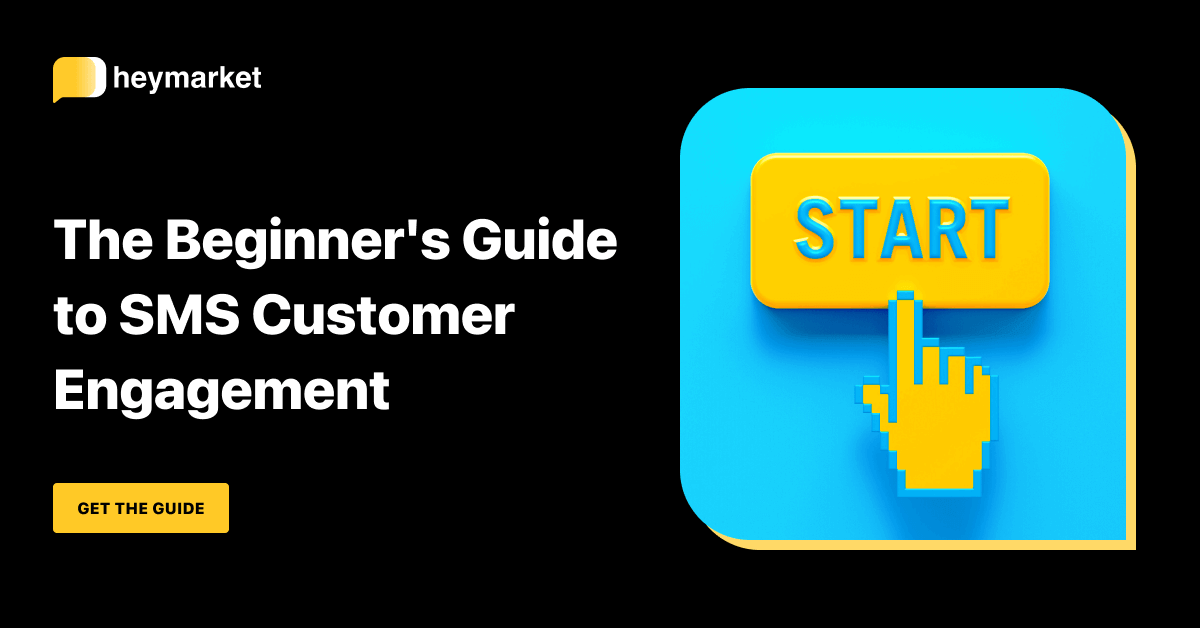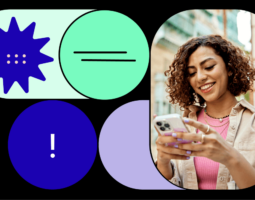
Conversational customer engagement is a new and popular strategy for business text messaging. It focuses on person-to-person conversations between businesses and their customers. These conversations are meant to build strong customer relationships that last.
While conversational customer engagement is often used by customer service and marketing teams, it’s also a powerful tool for sales teams. After all, sales are all about prospective and current customer relationships.
Read on to learn three ways your sales team can use conversational customer engagement.

Want a step-by-step look at building strong customer relationships through texting? Read our Beginner’s Guide to SMS Customer Engagement.
Get the guideEncourage Prospective and Current Customers to Reach Out
Conversational customer engagement focuses on inbound content. It offers strategies for answering prospective and current customers’ queries while creating strong bonds with them. The more customers you engage in these conversations, the better you’ll be able to detect opportunities to have sales conversations with them.
But customers have to message you before you can start chatting with them. Encourage them to write in by offering multiple entry points. Your omnichannel messaging platform can accept messages from native SMS sales apps as well as services like Facebook Messenger, WhatsApp, Apple Business Chat, and Google’s Business Messages.
To prompt customers to reach out to your team, feature channel entry points (e.g., your business SMS number, ABC badge, and GBM badge) on content customers access often, like email newsletters, help articles, social media pages, and your Contact Us page. If there’s room on the publication site, such as your Contact Us page, explain the following to streamline customers’ texting experience:
- The opt-in process (e.g., what keywords customers need to text in)
- The types of queries customers can submit (e.g., customer service questions as well as product and pricing questions)
- What content you and other teams may send periodically (e.g., polls, product announcements, and feedback requests)
Once customers write in, your business SMS platform should automatically reply with confirmation texts. A confirmation text may look something like this:
Hello {{customer name}}, Software Services here. You’ve signed up for our SMS services. Can we help with anything? Text STOP to unsubscribe.
Encouraging customers to text in starts conversations that can ultimately help you boost sales.
Ask Customer Service Teams to Loop You In
Depending on how your cross-team workflows are set up, there’s a good chance that most messages will go to your customer service team first. After all, prospective and current customers most often text in for service-related queries.
Ask customer service team members to loop in sales team members when customers need expert advice—or if they’re ready to make a purchase. (Your text messaging service for business should make that easy with help from private messages.)
Just be sure that your team follows conversational customer engagement best practices when those messages come your way. For example, you’ll need to:
- Use an authentic, natural tone (like you’re speaking to a new acquaintance)
- Personalize replies as much as possible with custom fields
- Encourage customers to ask questions
- Focus on building connections, not overt sales
A response to a looped-in question may look like the following example:
Hi {{customer name}}, I’m Tammy, Joe’s coworker on the product expert team. It sounds like you’re wondering whether you need to upgrade your subscription in order to adjust your user interface, is that right? Text STOP to unsubscribe.
Using conversational customer engagement strategies for inbound messages makes it easier for your team to make lasting connections. If customers feel comfortable chatting with your team, they’re more likely to reach out when they’re thinking about making a purchase in the future.
Publicize Q&A Sessions for Expert Advice
Your sales team is full of product or service experts. Few employees know your business’s offerings better. That’s why you need to let prospective and current customers access your sales team members as much as possible.
Let customers know that they can access product or industry experts through business text messaging. This way, they’ll be more likely to reach out and start conversations. Publicize your Q&A option on your website, social media pages, and any other customer communications, like marketing emails. You’ll also want to send SMS list members an SMS invitation.
When publicizing your Q&A service, be sure to include:
- Your business text messaging number
- A special keyword for customers who want to speak to sales team members directly
- A list of question types your team can answer
- A response time estimate
A sample SMS invitation to a Q&A service may look like the following example:
Hi {{customer name}} — great news! Our resident sports experts are available to answer any questions about shoes you have. Text EXPERT to start asking them your questions. Text STOP to unsubscribe.
Providing access to your experts will be sure to start conversations—which is what conversational customer engagement is all about.
Ready to boost your customer engagement strategy with business SMS? Read our Beginner’s Guide to SMS Customer Engagement.









